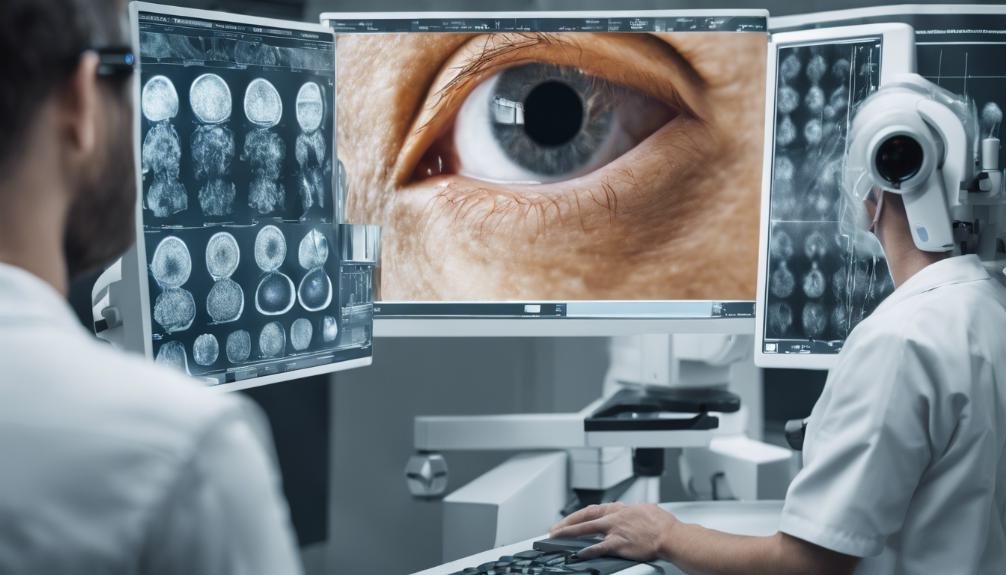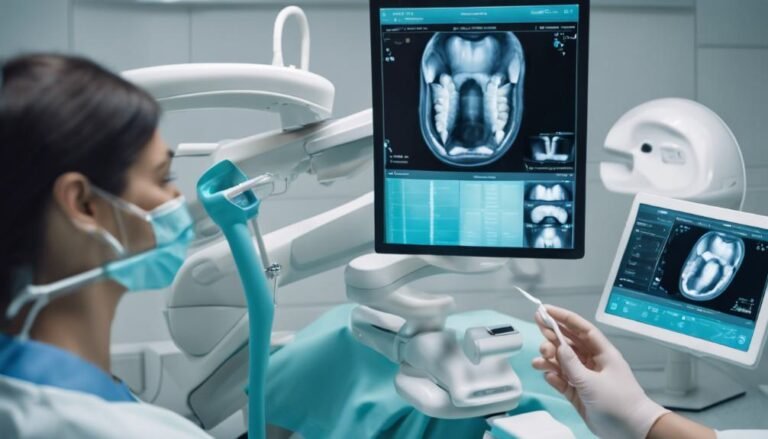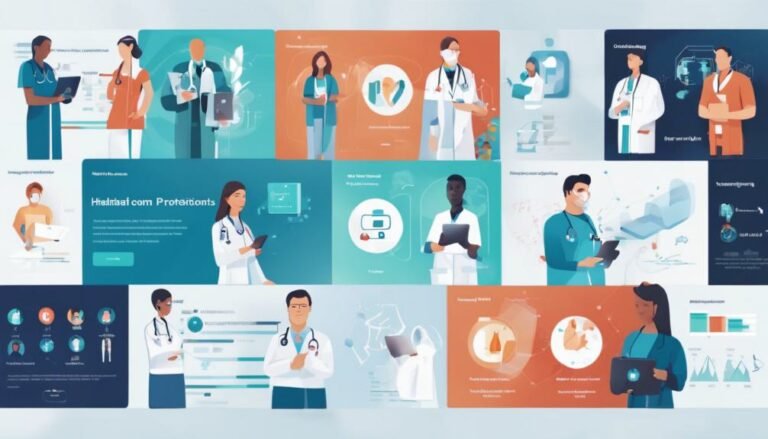AI for Ophthalmology Imaging
You might wonder about the reliability of AI in interpreting complex ophthalmic images, but the advancements in technology have shown promising results in enhancing diagnostic capabilities. The integration of artificial intelligence in ophthalmology imaging not only guarantees accurate and timely detection of eye diseases but also opens up new possibilities for personalized treatment strategies. With AI algorithms continuously evolving to analyze intricate details within images, the potential for revolutionizing eye care through innovative solutions is vast.
Key Takeaways
- AI enhances diagnostic accuracy in ophthalmology imaging.
- Streamlined workflows in healthcare facilities with AI integration.
- Early detection of challenging eye diseases enabled by AI.
- AI algorithms analyze imaging data swiftly and precisely.
- AI aids in personalized surgical planning for enhanced precision.
Evolution of Ophthalmology Imaging With AI
The integration of artificial intelligence (AI) in ophthalmology imaging has revolutionized the field, greatly enhancing diagnostic accuracy and improving patient outcomes. Emerging technologies have paved the way for AI integration in healthcare, leading to significant advancements in the diagnosis and treatment of eye conditions. By leveraging AI algorithms, ophthalmologists can now analyze complex imaging data with unprecedented speed and precision.
These advancements haven't only expedited the diagnostic process but have also enabled early detection of eye diseases that were previously challenging to identify in their initial stages. AI-powered systems can detect subtle changes in retinal images that might escape the human eye, allowing for timely interventions and improved prognosis for patients.
Furthermore, the use of AI in ophthalmology imaging has streamlined workflows in healthcare facilities, reducing the burden on ophthalmologists and enhancing overall efficiency. As these technologies continue to evolve, the future of ophthalmology imaging looks promising, with AI playing a central role in driving innovation and improving patient care.
Applications of AI in Diagnosing Eye Diseases
AI technology in ophthalmology imaging has been instrumental in advancing the diagnosis of various eye diseases through its innovative applications. One key area where AI has made a significant impact is in retinal screening. By utilizing AI algorithms to analyze retinal images, healthcare providers can now detect signs of diabetic retinopathy, age-related macular degeneration, and other retinal conditions with remarkable accuracy.
The use of AI for retinal screening has revolutionized the early detection of eye diseases, enabling prompt intervention and treatment to prevent vision loss. AI algorithms can efficiently scan large datasets of retinal images, identifying subtle changes that might escape the human eye.
This has led to a substantial improvement in diagnostic accuracy, reducing the risk of misdiagnosis and ensuring timely management of eye conditions.
Enhancing Surgical Procedures With AI Technology
AI technology is revolutionizing ophthalmic surgical procedures. It aids in surgical planning, providing real-time image analysis, and enhancing precision during operations.
With AI assisting in surgical planning, doctors can optimize their approach based on personalized data and predictive analytics.
Real-time image analysis capabilities allow for immediate feedback during surgery, ensuring precise and accurate interventions.
AI in Surgical Planning
Utilizing advanced algorithms and image recognition technology, surgeons can now enhance their procedural planning through the integration of artificial intelligence. AI plays a pivotal role in surgical assistance by providing predictive outcomes based on vast datasets and intricate algorithms.
Before the actual procedure, preoperative simulations powered by AI enable surgeons to visualize different scenarios, anticipate challenges, and plan the most effective approach tailored to each patient. These simulations not only optimize the surgical plan but also enhance the overall precision and success rates of the procedure.
Moreover, AI doesn't stop its assistance once the surgery is completed. It continues to be invaluable in analyzing postoperative results, comparing them to the predicted outcomes, and refining future surgical strategies.
Real-Time Image Analysis
Enhancing surgical procedures with real-time image analysis technology provides ophthalmologists with immediate insights into intricate details for precise decision-making during operations.
Real-time analytics enable continuous monitoring of images during surgery, allowing for quick adjustments based on live data. Through image recognition capabilities, AI systems can identify anatomical structures, abnormalities, and changes in real-time, aiding surgeons in maintaining accuracy throughout the procedure.
Moreover, the integration of data from various sources such as pre-operative scans, intraoperative images, and historical patient information enhances the overall surgical process. This integration allows for a thorough analysis of the patient's ocular condition, leading to more informed decisions and personalized treatment plans.
Remote monitoring capabilities further expand the reach of real-time image analysis, enabling collaboration between surgeons in different locations. This feature facilitates knowledge sharing and can provide expert guidance during complex procedures, ultimately improving surgical outcomes and patient care.
Precision During Procedures
By integrating AI technology, surgeons can enhance the precision of ophthalmological procedures through real-time image analysis. AI algorithms can assist in identifying critical structures with unparalleled accuracy during surgeries, enabling surgeons to operate with increased confidence and precision. These AI-powered systems analyze intricate details in real time, providing valuable insights that help in making informed decisions during delicate procedures.
Remote monitoring plays an essential role in ensuring that surgical procedures are conducted with the utmost precision. Through AI technology, specialists can remotely monitor surgeries, providing guidance and support in real time. This not only enhances the precision of procedures but also enables collaboration between experts regardless of their physical location.
Moreover, data security is a paramount consideration when implementing AI in ophthalmological procedures. Advanced encryption techniques and strict access controls must be in place to safeguard patient information and ensure compliance with data protection regulations. By prioritizing data security, healthcare providers can harness the power of AI technology without compromising patient confidentiality.
Improving Efficiency in Image Interpretation
You can expect AI technology to accelerate diagnosis times by swiftly analyzing ophthalmology images. By harnessing AI's capabilities, accuracy in interpreting complex images can be greatly enhanced, aiding in more precise diagnoses.
Additionally, integrating AI into image interpretation processes can streamline workflow efficiencies, optimizing patient care delivery in ophthalmology practices.
Speeding up Diagnosis
To accelerate the diagnostic process and enhance efficiency in image interpretation within ophthalmology, incorporating artificial intelligence (AI) holds significant promise. AI technology enables remote monitoring of ophthalmic images, facilitating early detection of eye conditions. By utilizing AI algorithms, ophthalmologists can streamline the diagnosis process, leading to quicker treatment initiation and improved patient outcomes.
Remote monitoring through AI allows healthcare providers to assess ophthalmic images in real-time, regardless of the patient's location. This capability is essential for early detection of eye diseases such as diabetic retinopathy or glaucoma, where timely intervention is crucial to prevent vision loss. AI algorithms can analyze vast amounts of data swiftly, flagging potential abnormalities for further review by healthcare professionals.
Enhancing Accuracy With AI
Utilizing artificial intelligence (AI) in ophthalmology imaging greatly enhances the importance and thoroughness of image interpretation processes. By training algorithms on vast amounts of data, AI systems can learn to detect intricate details and patterns that might be overlooked by the human eye. This enhanced accuracy leads to more precise diagnoses and early detection of eye conditions, ultimately improving patient outcomes.
Data integration plays a vital role in the effectiveness of AI for ophthalmology imaging. By integrating various sources of data such as patient history, genetic information, and previous imaging results, AI systems can provide a more thorough analysis. This all-encompassing approach not only enhances the accuracy of diagnoses but also helps in creating personalized treatment plans tailored to individual patients.
Streamlining Workflow Processes
Efficiency in image interpretation within ophthalmology can be greatly enhanced through the strategic implementation of streamlined workflow processes. Workflow optimization plays an essential role in improving the overall efficiency of image interpretation tasks.
By integrating technology into these processes, ophthalmology practices can notably reduce the time taken for image analysis and diagnosis. Technology integration allows for seamless data sharing among healthcare professionals, enabling quicker consultations and collaborative decision-making.
Automated systems can prioritize urgent cases, ensuring timely interventions for patients requiring immediate attention. Additionally, implementing electronic health records (EHR) and digital imaging systems can centralize patient data, further expediting the diagnostic process.
Streamlining workflow processes not only improves efficiency but also enhances the quality of care provided to patients. By reducing manual tasks through automation and integrating advanced technologies, ophthalmology practices can optimize their operations and allocate resources more effectively.
Embracing these innovations is essential in meeting the increasing demands for timely and accurate image interpretation in ophthalmology.
Challenges in Implementing AI for Ophthalmology
Implementing AI for ophthalmology faces significant hurdles due to the complexities of image interpretation and the need for tailored algorithms to accurately analyze intricate eye structures. One major challenge is ensuring data privacy, as patient information within ophthalmic images must be protected to comply with regulations and maintain patient trust.
Developing AI systems that can effectively anonymize and secure this sensitive data while still allowing for accurate analysis presents a significant obstacle. Moreover, the training requirements for AI algorithms in ophthalmology are demanding. Ophthalmic imaging is a specialized field that requires extensive expertise to interpret accurately.
Training AI systems to recognize the subtle nuances and variations in eye conditions demands a large volume of high-quality annotated data. Obtaining and curating such datasets to train AI models effectively is labor-intensive and time-consuming, posing a barrier to the widespread implementation of AI in ophthalmology.
Addressing these challenges is essential for the successful integration of AI into ophthalmic imaging practices, and overcoming these obstacles will be necessary for realizing the full potential of AI in revolutionizing eye care.
Future Trends and Innovations in Ophthalmic AI
In the field of ophthalmology imaging, the horizon of AI is poised to usher in a wave of transformative advancements and cutting-edge innovations. AI advancements in ophthalmic imaging are rapidly evolving, with technologies like deep learning algorithms enhancing diagnostic accuracy and efficiency. Clinical trials are increasingly integrating AI tools to streamline processes and improve patient outcomes. These trials are demonstrating the potential of AI to assist ophthalmologists in detecting eye diseases earlier and with greater precision, ultimately leading to better treatment outcomes.
Moreover, the implementation of AI in ophthalmology raises important considerations regarding data privacy. As AI systems rely heavily on vast amounts of patient data for training and analysis, ensuring the protection and confidentiality of this sensitive information is vital. Innovations in data encryption and secure storage protocols are essential to maintaining patient trust and compliance with regulatory standards in the evolving landscape of AI-driven healthcare technologies.
Ethical Considerations in AI-Driven Ophthalmology
Embracing ethical considerations is crucial when integrating AI technology into ophthalmology practices, prioritizing patient well-being and trust in the utilization of advanced imaging tools.
Data privacy is a critical aspect when handling sensitive medical information through AI-driven ophthalmic systems. Safeguarding patient data from breaches and unauthorized access is essential to maintain confidentiality and trust in the healthcare setting.
Algorithm bias is another key ethical consideration in AI-driven ophthalmology. Ensuring that algorithms are developed and trained on diverse and representative datasets can help mitigate bias in diagnostic outcomes and treatment recommendations. Transparent validation processes are necessary to identify and rectify any biases that may arise during the development and deployment of AI algorithms in ophthalmology.
Patient consent plays a crucial role in the ethical deployment of AI technology in ophthalmology. Obtaining informed consent from patients regarding the use of AI-driven imaging tools is important to respect patient autonomy and ensure they're aware of how their data will be utilized.
Regulatory compliance with existing laws and guidelines further reinforces the ethical framework within which AI technologies should operate in ophthalmology practices.
Conclusion
To sum up, AI for ophthalmology imaging is a game-changer in the field, enhancing diagnostic accuracy, surgical precision, and overall workflow efficiency.
Embracing this technology is like seeing the world through a new lens, providing insights and opportunities previously unseen.
Despite challenges, the future of ophthalmic AI holds immense potential for advancing patient care and revolutionizing the way eye diseases are diagnosed and treated.
It's time to focus on the horizon and embrace the transformative power of AI in ophthalmology.







